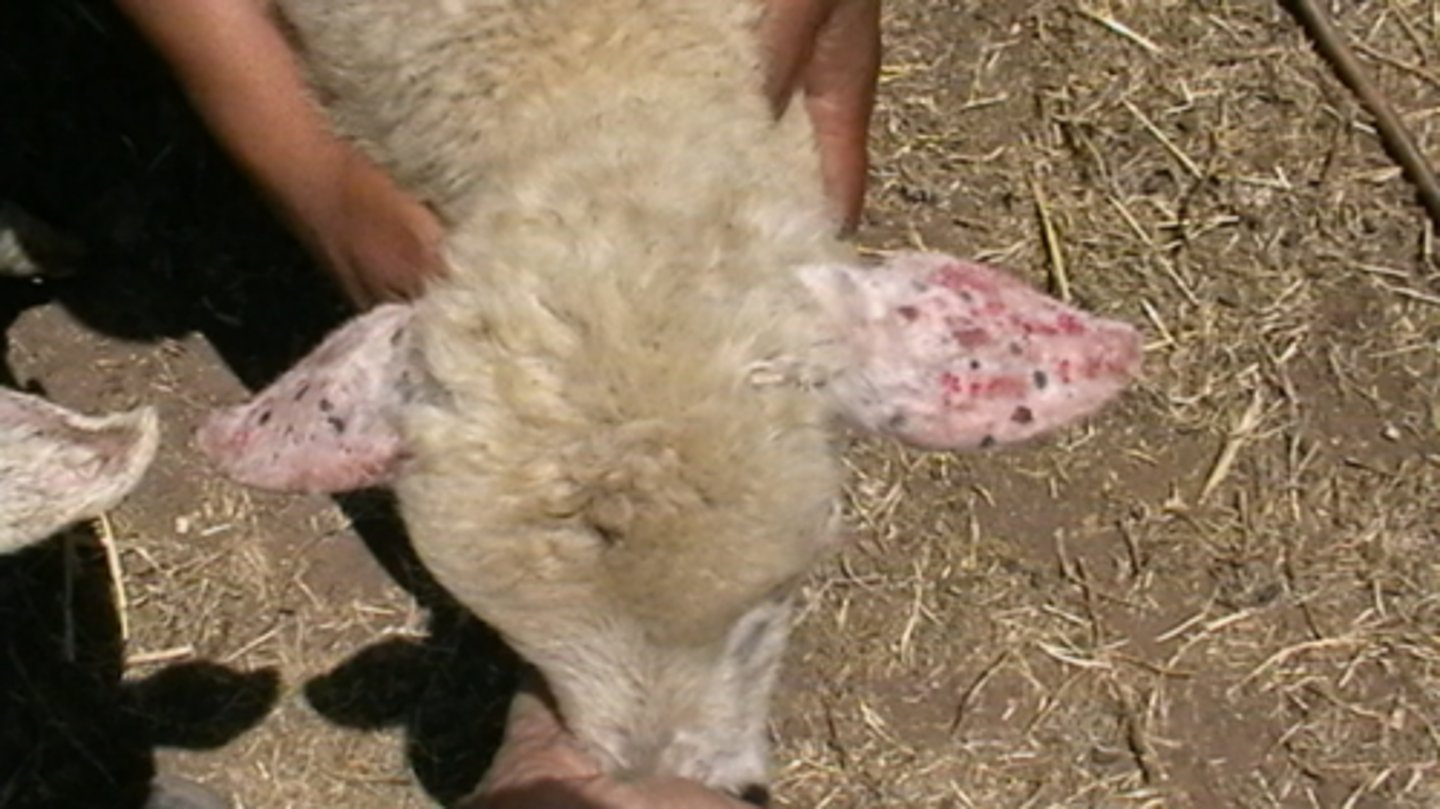Integument Function
1/72
There's no tags or description
Looks like no tags are added yet.
Name | Mastery | Learn | Test | Matching | Spaced |
|---|
No study sessions yet.
73 Terms
-Protection/ boundary
-Thermoregulation
-Secretion
-Sensory
-Pigmentation
-Motion and shape
-Storage
-Vitamin D metabolism
-Synthesis and glandular
-Immuno-surveillance
-Capture of prey
-ID
List some functions of the integument system
The temperature of the brain, thorax and abdomen.
What is core temperature?
The ability of an organism to keep its body temperature within certain boundaries, even when the surrounding temperature is different.
What is thermoregulation?
37.5-39.5 degrees.
What is the normal temperature of a dog
-Metabolic rate
-Production level
What may core temperature vary with?
-Autonomic control of blood supply to the skin and contraction/relaxation of the erector pili muscle
-Evaporative heat loss (sweating/panting)
-Thermogenesis (shivering and non-shivering)
How is temperature physiologically thermoregulated
A = Epidermis
B = Dermis
C = Hypodermis (subcutis)
D = Adipose tissue
E = Erector pilli muscle
F = Autonomic Nerve Fibres
Label this sectional view of the skin and the subcutaneous layer
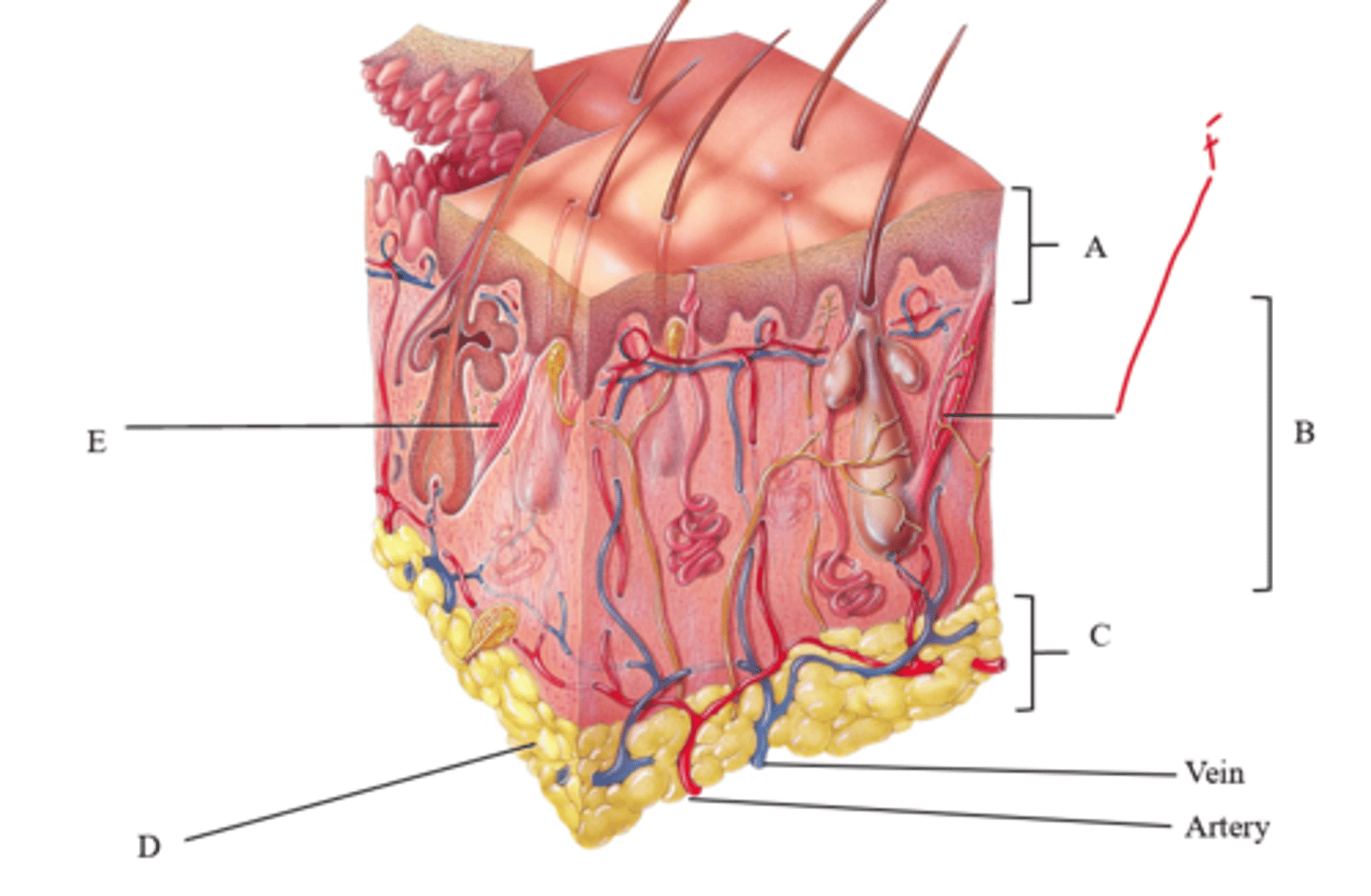
-Stimulates contraction of vascular smooth muscle controlling resistance in small blood vessels
-Stimulates contraction of erector pilli muscle, adjusting the insulating properties of fur and plumage by increasing the thickness of the trapped layer of air
State the thermoregulatory effects of the sympathetic nervous system on the integument system
-Decreased sympathetic activity
-Relaxation of resistance arterioles (so blood is shunted to the dermis)
-Erector pilli are relaxed (so there is less trapped hair)
Summarise what occurs in the integument system when there are high ambient temperatures
-Increased sympathetic activity
-Contraction of resistance arterioles (so there is reduced blood flow to the dermis)
--Subcutaneous fat layer also provides insulation against heat loss from vasculature
-Erector pilli contracts (so there is increased trapped air from fur)
Summarise what occurs in the integument system when there are low ambient temperatures
It varies widely (up to a factor of 3-5 based on need to dissipate heat).
Is skin temperature constant or does it vary?
-Insensible
-Because water loss this way is unregulated
Is evaporative heat loss sensible heat loss or insensible? Why?
-Panting
-Sweating
-Wetting the body
What are the mechanisms of evaporative heat loss in domestic species?
-Horses = high
-Cattle and sheep = moderate
-Pigs, dogs, cats = minimal
State how much a cow, horse, sheep, pig, dog and cat relies on sweating for evaporative heat loss
Panting.
What mechanism do cats, dogs and pigs rely on for evaporative heat loss?
-Panting is rapid and shallowing breathing at a natural frequency of oscillation so little energy is expended on muscle activity
-Water loss is mainly lost through the turbinates (not the mouth) as it is highly vascularised and has a very large SA
-Heat and water exchanges with the dry air inhaled in which then exits through the mouth
Describe how panting causes evaporative heat loss
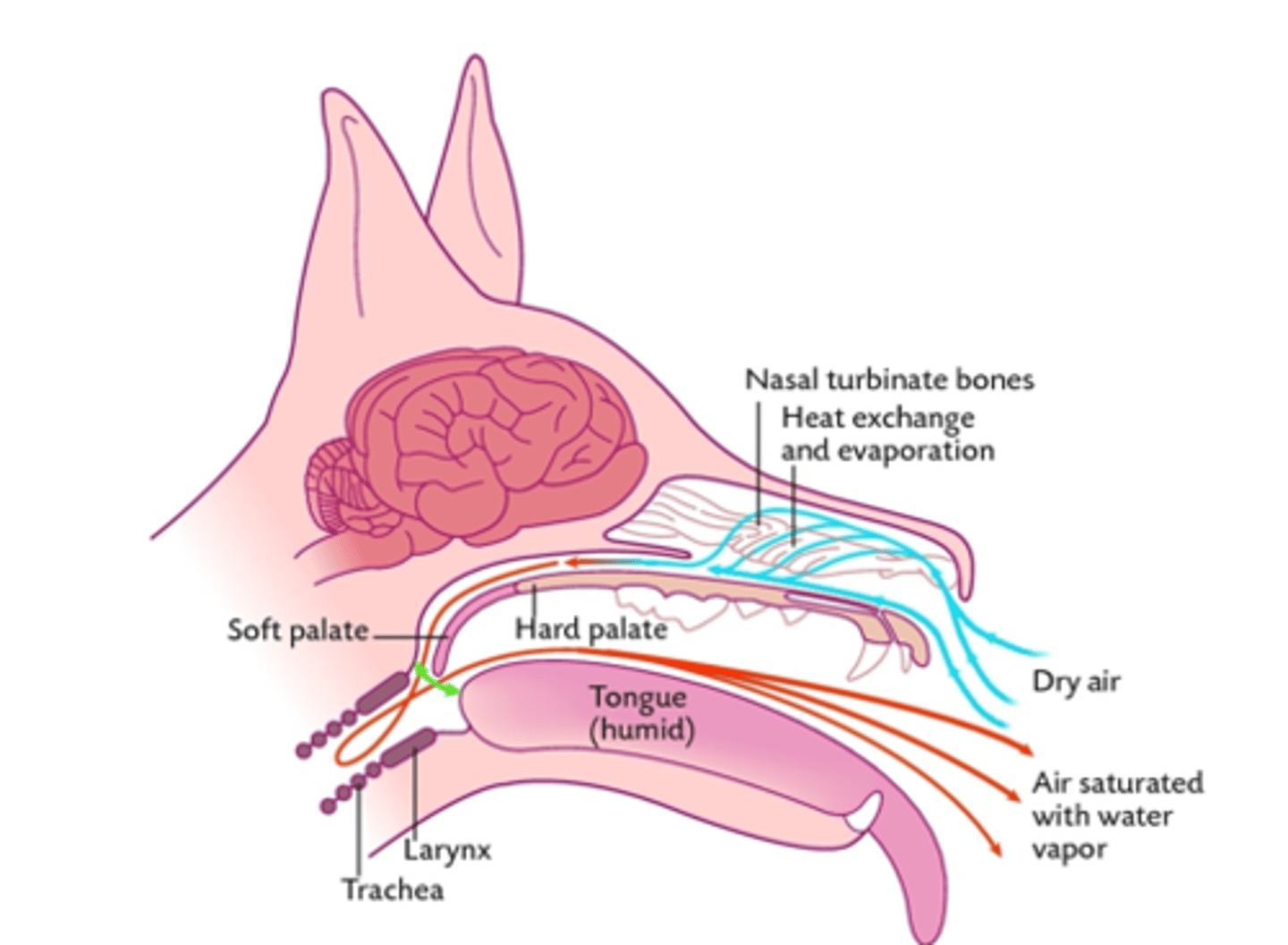
-The animal is not moving air into the alveoli so the ventilation rate is not altered and hence no respiratory alkalosis will occur
-Remember that the pathway of most air for panting is through the nasal turbinates into the start of the trachea, then back out through the mouth.
Why doesn't a panting animal develop respiratory alkalosis?
-Heart
-Brain
-Liver
-Kidneys
In an animal, where does most heat production take place in?
~80%.
How much extra energy is converted to heat during voluntary exercise?
Shivering:
-Primary involuntary means of increasing heat production
-Uses skeletal muscle
Non-shivering:
-Increasing basal metabolic rate
-Uses brown fat, thyroid hormone
-Does NOT use skeletal muscle
What are the 2 main types of thermogenesis? Describe them
-Newborn lambs
-Hibernating animals
Which animals heavily rely on brown fat for thermogenesis?
-Uncoupled skeletal muscle
-Sympathetic nervous system
What is brown fat? What stimulates its oxidation for thermogenesis?
-Thyroid hormone = prolonged
-Brown fat = short
Do thyroid hormones cause prolonged increase in metabolism or a short increase in metabolism? What about brown fat?
Conserve heat:
-Vasoconstriction
-Behaviour (e.g. posture, heat-seeking)
Generate heat (thermogenesis):
-Shivering
-Non-shivering
-Increase appetite
Summarise the homeostatic mechanisms an animal uses to increase core body temperature
Lose heat:
-Vasodilation
-Behaviour (e.g. seeking shade, open posture)
Evaporative heat loss:
-Sweating
-Panting
-Behaviour (e.g. wallowing)
Decreased appetite
Increased thirst
Summarise the homeostatic mechanisms an animal uses to decrease core body temperature
-Changes in peripheral blood flow
-Minor changes in behaviour (e.g. posture)
Which thermoregulatory mechanisms use little/no energy?
-If they are not in their TNZ, this means they will have the rely on thermoregulatory mechanisms to alter their core body temperature
-Most thermoregulatory mechanisms require energy
-For production animals, this means that their is feed conversion inefficiency as less energy is being used to produce
Why is it essential to keep production animals in their thermoneutral zone (TNZ)?
Calcium homeostasis.
What is vitamin D important for?
-Vitamin D3 (Cholecalciferol)
-Uses UV rays to convert a vitamin D precursor into Vitamin D3
Which form of vitamin D is synthesised in the skin? How?
-Dense fur coat
-Heavy pigmentation
How may vitamin D3 synthesis in the skin be inhibited?
-Alpacas
-Because they have very dense wool and heavily pigmented skin
Which animals are significantly at risk of vitamin D3 deficiency in the UK? Why?
Rickets.
What disease is typically a result of vitamin D3 deficiency?
-Vasodilation
-Open posture
-Behaviour (e.g. wallowing, eat less, drink more, move less)
-Panting
List the mechanisms that a pig will use to regulate its temperature on a hot, sunny day
-Pyrogens increase the hypothalamic set point to a higher value than normal
-This means that the animal will feel cold at normal temperatures
-Give paracetamol as it inhibits the production of pyrogens
If an animal is infected with a systemic illness that releases pyrogens, why my it be shivering even though its core body temperature is within normal limits? How can you treat this on a basic level? Why?
-They have an increased SA
-They aren't moving
-Heat is lost through incision and prep
-We put them on a heater pad to keep them warm
Why are small anaesthetised patients at risk of hypothermia? What do we do to reduce this risk?
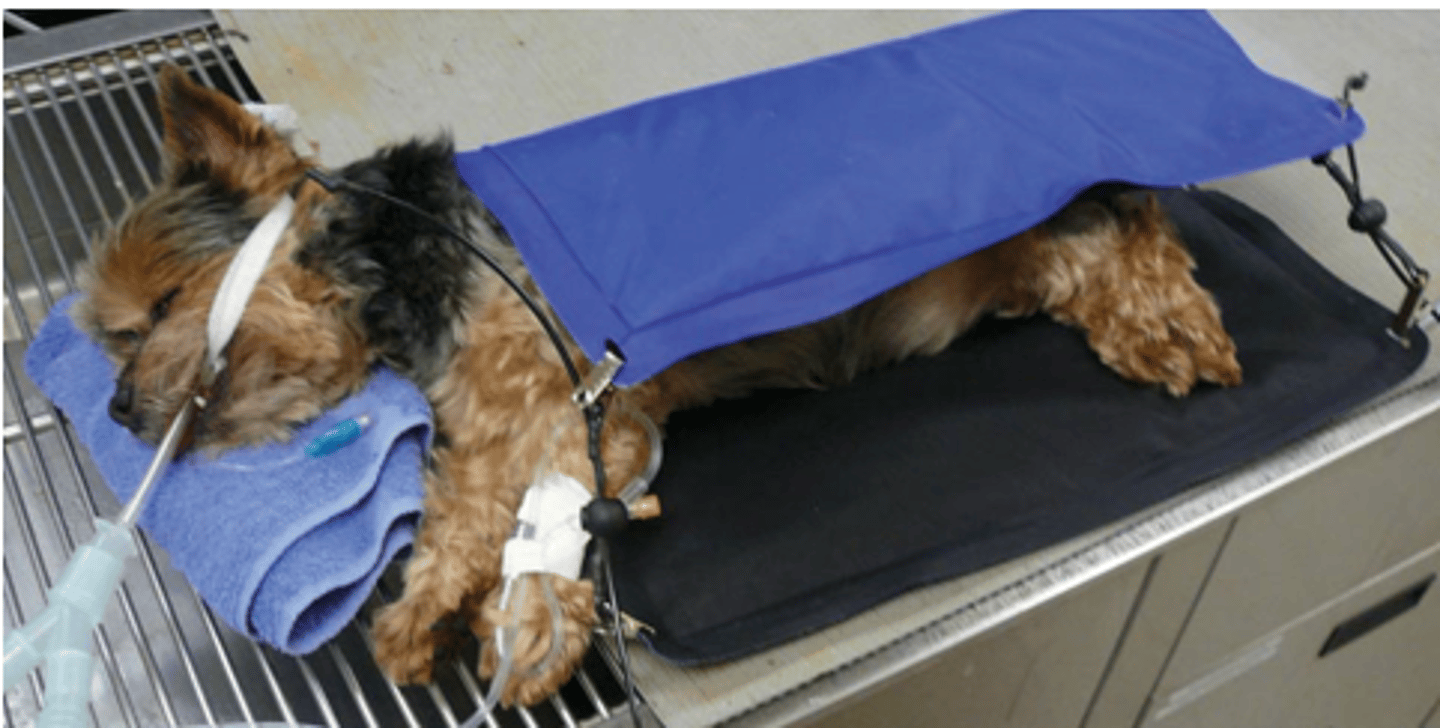
-Anagen = growing phase
-Catagen = transition phase with regression of the lower part of the hair follicle
-Telogen = resting phase
State the phases of hair growth
-Genetics
-Age
-Hormones
-Photoperiod (influenced by prolactin and melatonin)
What is the hair growth cycle affected by?
-Allows seasonal changes in coat density
-E.g. shedding the winter coat
Describe why the way the photoperiod effects the growth cycle of hair in domestic species is significant
-Ganglion cells (specialised ocular light cells) detect light from dark
-These cells relay that information back to the pineal gland that produces melatonin when in the dark
-Changes to levels of melatonin alter photoperiod perception (e.g. as long or as short)
How is photoperiod detected?
-They do
-Their hair follicles have a long anagen phase and a slower telogen phase
-This means that less hair follicles are shed over time
Why don't poodles moult?
-Promotes anagen
-Inhibits the start of catagen
Favours hair growth
What is the effect of thyroid hormones on the hair growth cycle?
-Bilateral, symmetrical alopecia
-As thyroid hormone is not being produced in adequate amounts
--Hence more hair is lost than grown
What is a classic clinical sign of hypothyroidism in domestic species? Why?
Thyroid hormone.
What hormone improves coat quality?
A = Sebaceous gland (as its duct is directly in the hair follicle)
B = Sweat gland (Ecrine)
C = Sweat gland (Apocrine)
D = Hair shaft
Label this skin segment
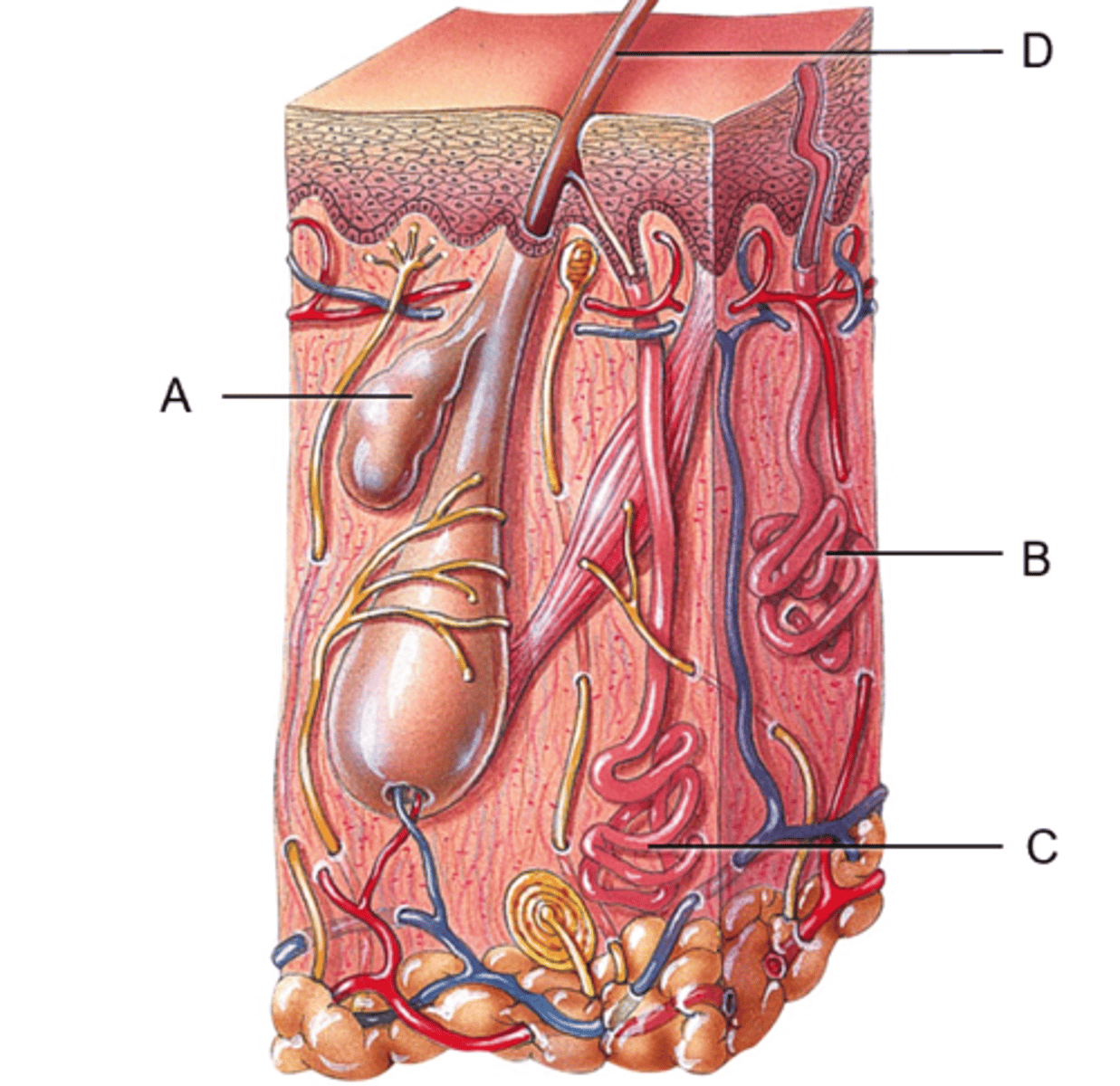
-Sebum
-It is a mixture of lipids (triglycerides, cholesterol esters, waxes) and dead epithelial cells
What substance do sebaceous glands secrete? What are its components?
When the piloerector muscles contract (they squeeze the gland).
When is sebum secreted by integument?
-Oils hairs
-Forms an oily film on the skin
-Retards water loss
-Lubricates skin
-Inhibits growth of certain bacteria
-Helps spread sweat
-Territorial marker
What are the functions of sebum?
No, but it is not very permeable to water.
Is skin waterproof?
-Sebaceous gland secretions
-Insoluble keratin within keratinocytes
How is water resistance of the skin increased?
-Sex steroid hormones (e.g. androgens)
-They are more active after puberty
-They become larger and more productive in breeding season
-Androgens increase activity
What regulates the activity of sebaceous glands? How?
Sebaceous gland secretions.
During breeding season, what causes a male to have a scent?
Lanolin.
What is the name of the sebum that sheep produce?
-No sebaceous glands within feathers
-During preening, birds spread their secretions from a gland at the base of their tail (uropygial gland)
Describe the differences in sebaceous glands of a bird compared to domestic species
-Common in domestic species
-Important in evaporative heat loss (particularly in horses and cattle)
-Sympathetic adrenergic
-Oily opaque secretion initially odourless but becomes smelly with bacterial breakdown
-Contains myoepithelial cells
Describe apocrine sweat glands
-Common in primates
-Important in evaporative heat loss
-Sympathetic cholinergic
-Secrete watery NaCl solution (Na levels modulated by aldosterone)
-Odourless
-Contains myoepithelial cells
Describe ecrine sweat glands
-Not commonly found in domestic animals (ecrine)
-Both contain myoepithelial cells
-Both important in evaporative heat loss
-Different neurotransmitter used for each
-Solutions secreted are different
Compare ecrine sweat glands with apocrine
-Horse, cattle, humans = abundant and very important
-Sheep and goats = moderate distribution with local importance
-Dogs, cats, pigs = Sparse with little importance
State the distribution and thermoregulatory importance of sweat glands in the horse, cattle, humans, sheep, goats, dogs, cats and pigs
Function:
-Sexual attraction
-Initiates mating behaviours in sows
Found in boars
Location:
-Opening of foreskin
What is the function of the preputial glands? What species are they found in? Where are they found?
Function:
-Territorial marking
Found in Sheep
Location:
-Rostral to medial canthus
What is the function of the infraorbital pouch skin gland? What species is it found in? Where is it found?
Function:
-Releases fatty secretion during defaecation
-Signature on faeces for territorial marking
Found most commonly in dogs but also in skunks and minks for a different function
Location:
-Interior anus
What is the function of anal glands? What species are they found in? Where are they found?
Function:
-Produces a fatty secretion
-Marking of footprints as signal to other animals in the flock
Found in the sheep, goat and deer
Location:
-Between the digits of all limbs
What is the function of the interdigital glands?
What species are they found in? Where are they found?
Function:
-Territorial marking
Found in dogs and cats
Location:
-Oval patch on dorsal tail
-More proximal in cats (towards the base of the tail)
What is the function of the tail gland? What species is it found in? Where is it found?
Melanin used for:
-Camouflage
-Mimicry
-Social communication
-Protection of keratocytes from UVB radiation damage
Why is the production of melanin important?
-Melanocytes
-Melanocyte cells extend between the stratum spinosum (between many keratinocytes)
--Intact vesicles containing melanin are transferred to adjacent keratinocytes (causing pigmentation of skin and hair)
What cells produce melanin? How is it distributed amongst skin cells?
-Eumelanins = black and brown
-Pheomelanins = red and yellow
What are the main pigments of melanins? What colour do they give?
COMPLEX:
-Genetic
-Local factors in skin
-Hormones
What controls pigment synthesis?
-Melanocyte stimulating hormone is produced by the pars intermedia of the pituitary gland (and also directly by melanocytes)
-MSH binds to its receptor which is coupled by a G protein which stimulates tyrosinase
-This causes eumelanin to be produced
How is the synthesis of melanin regulated?
Pheomelanins are produced so the skin and hair appears more red/yellow.
What occurs if MSH receptors are not activated?
-UV light
-Disease states (e.g. Cushings syndrome)
-Other external signals
What is the production of MSH stimulated by?
-Free nerve endings
-Pacinian corpuscles
-Disc-shaped nerve endings
-Nerve endings surrounding hair follicles
List the type of sensory cells in the skin
-Mechanical stimulation
-Pain
-Temperature
What is the skin sensitive to?
-It is where the skin is more sensitive to light than it should be
-Has many causes but is de to photosensitive compounds accumulating below the skin
-Can be due to kidney damage, congenital problems with pigment metabolism, ingestion of poisonous plants
What is photosensitisation? What is it caused by?
Photosensitisation.
What is this an example of?
